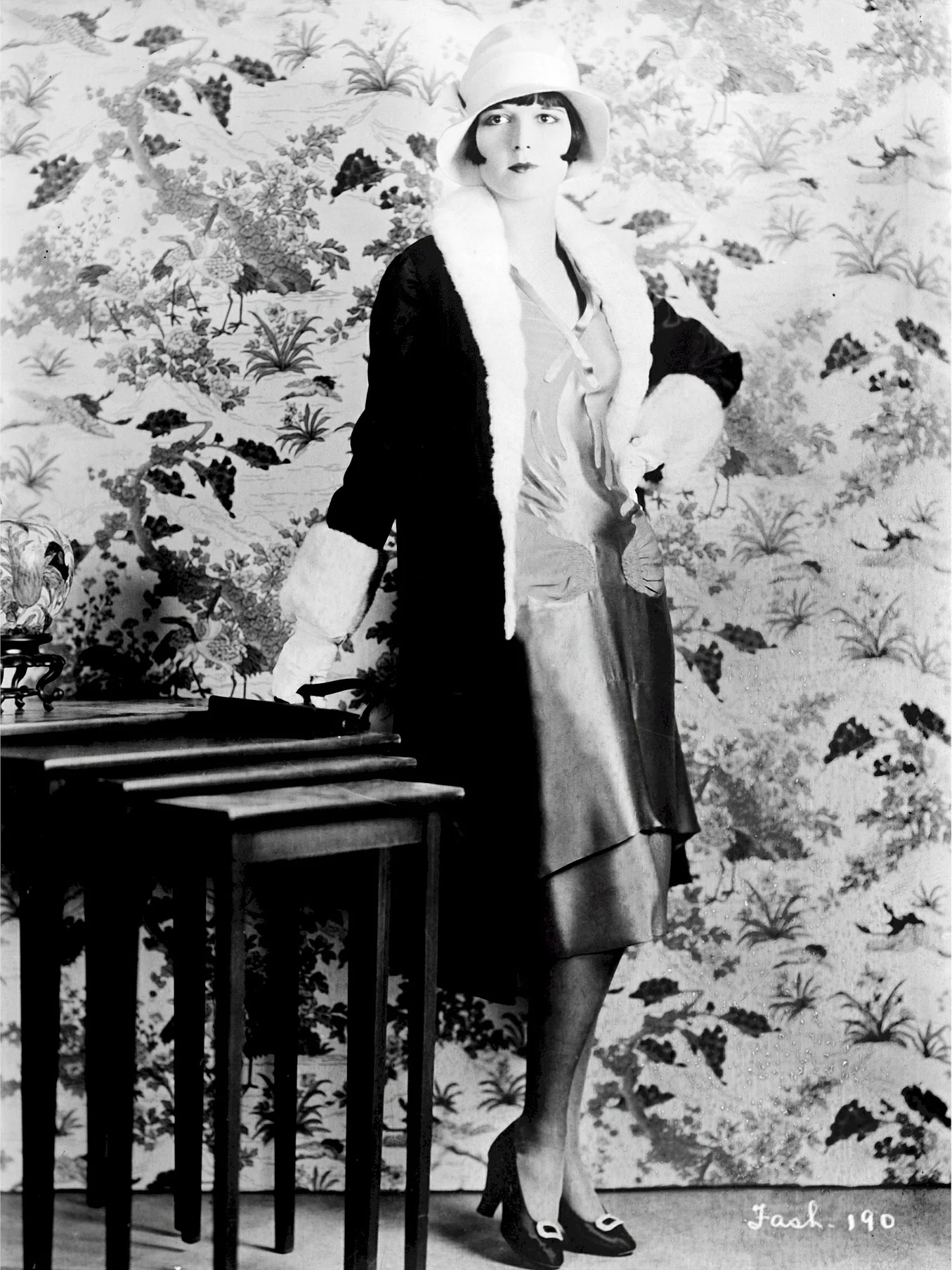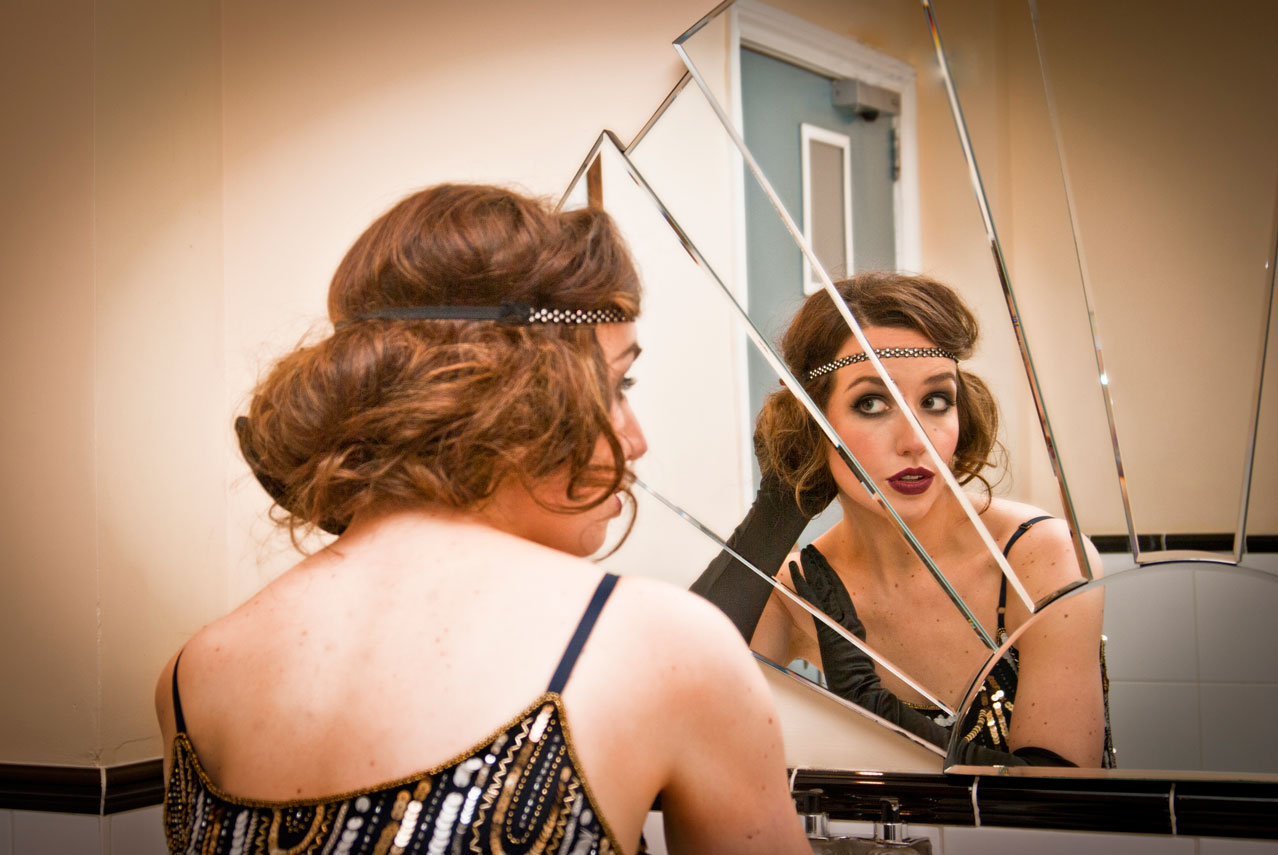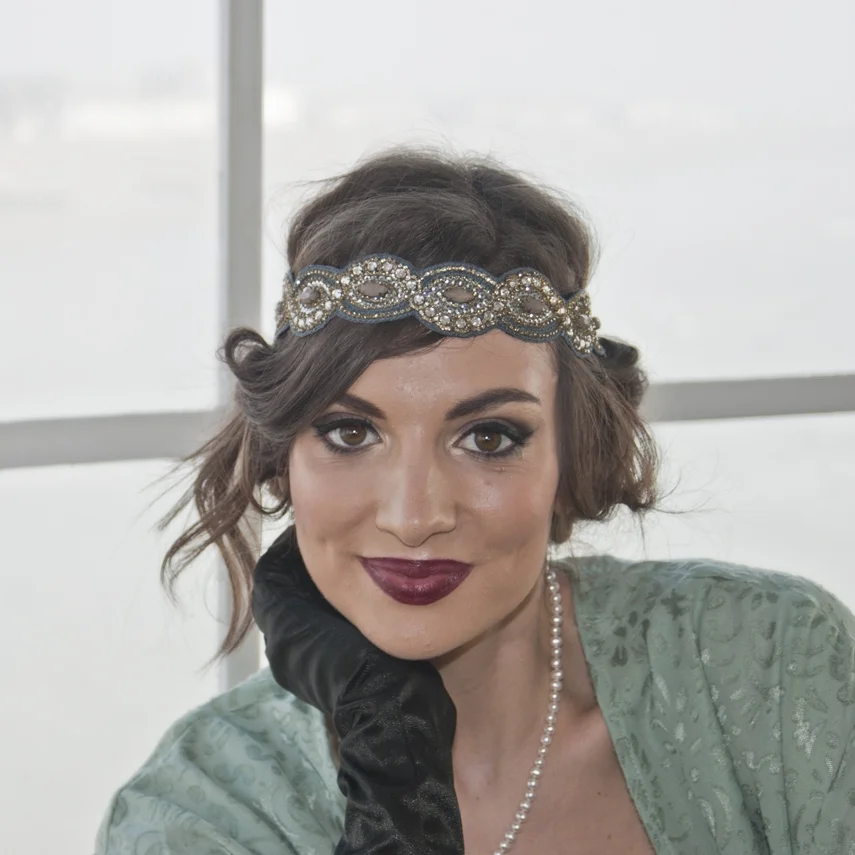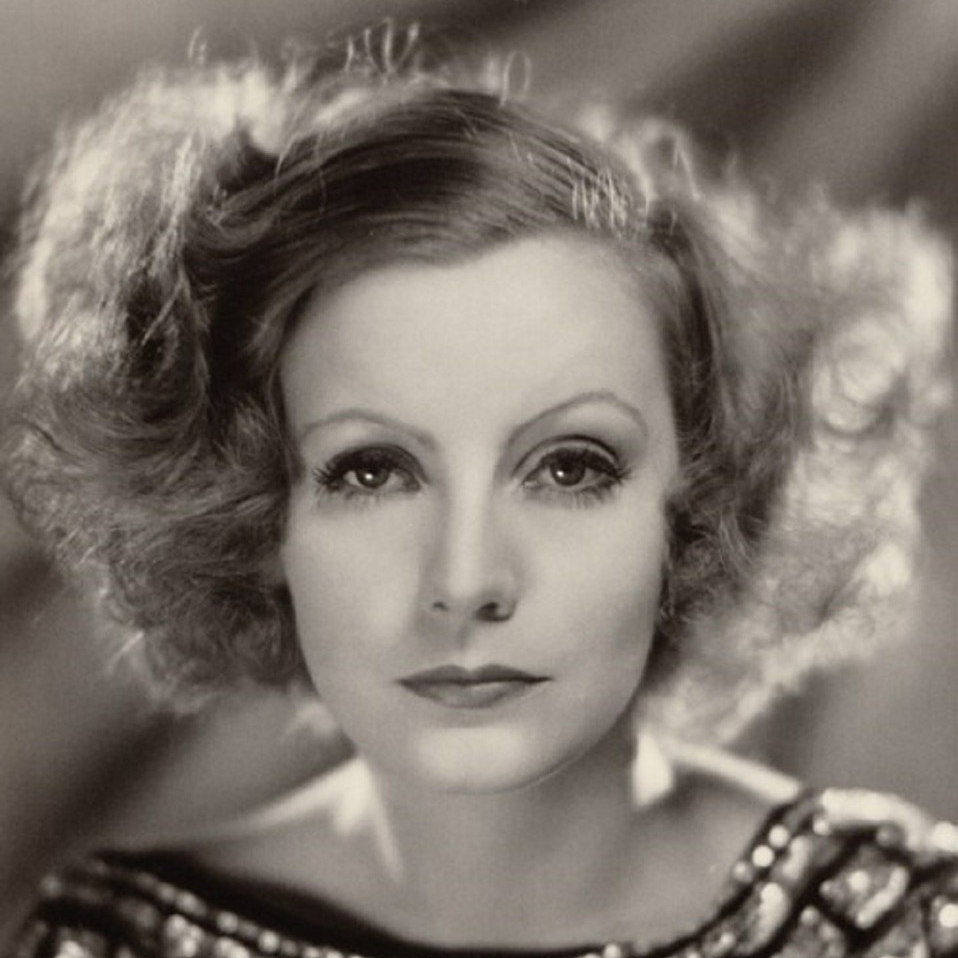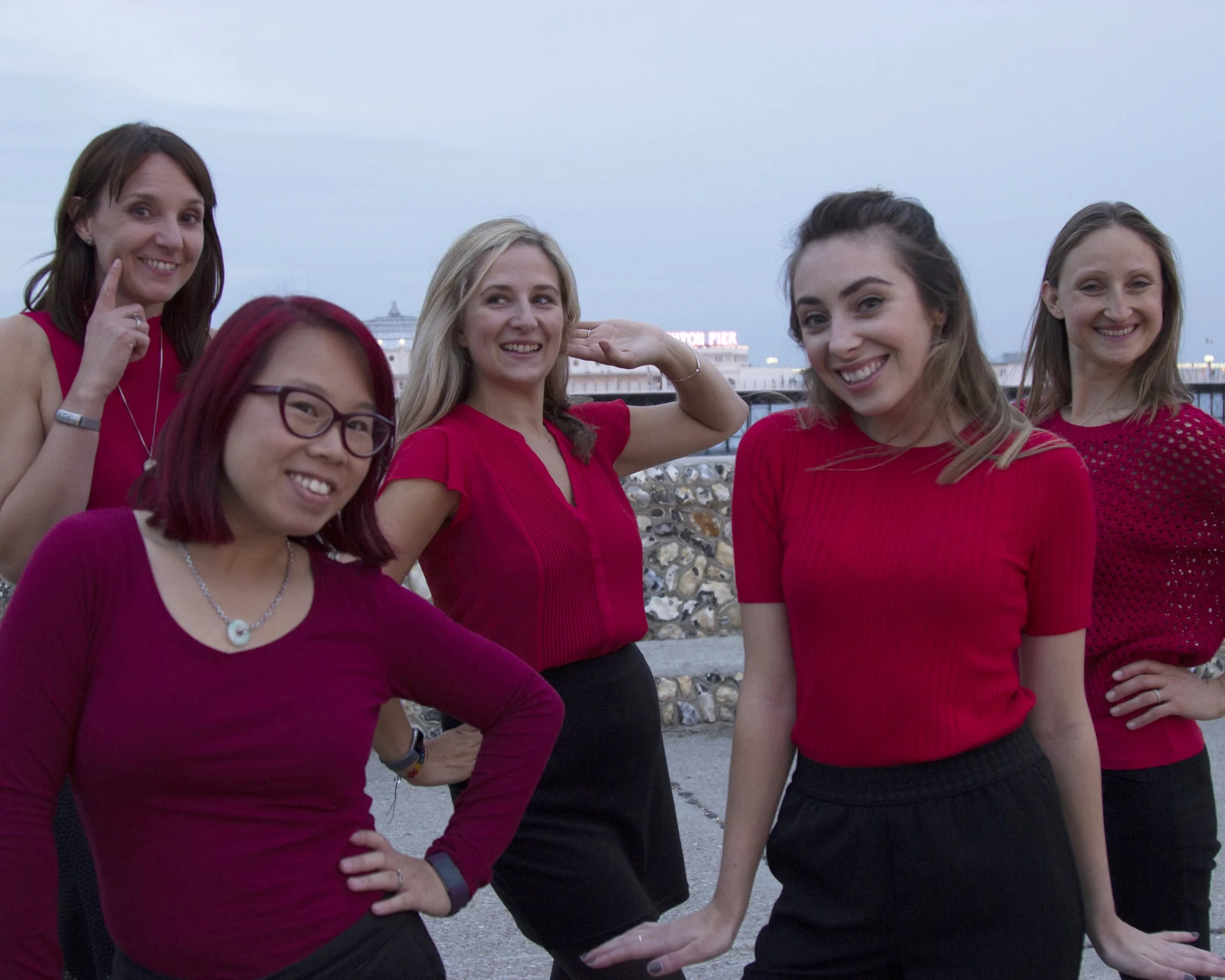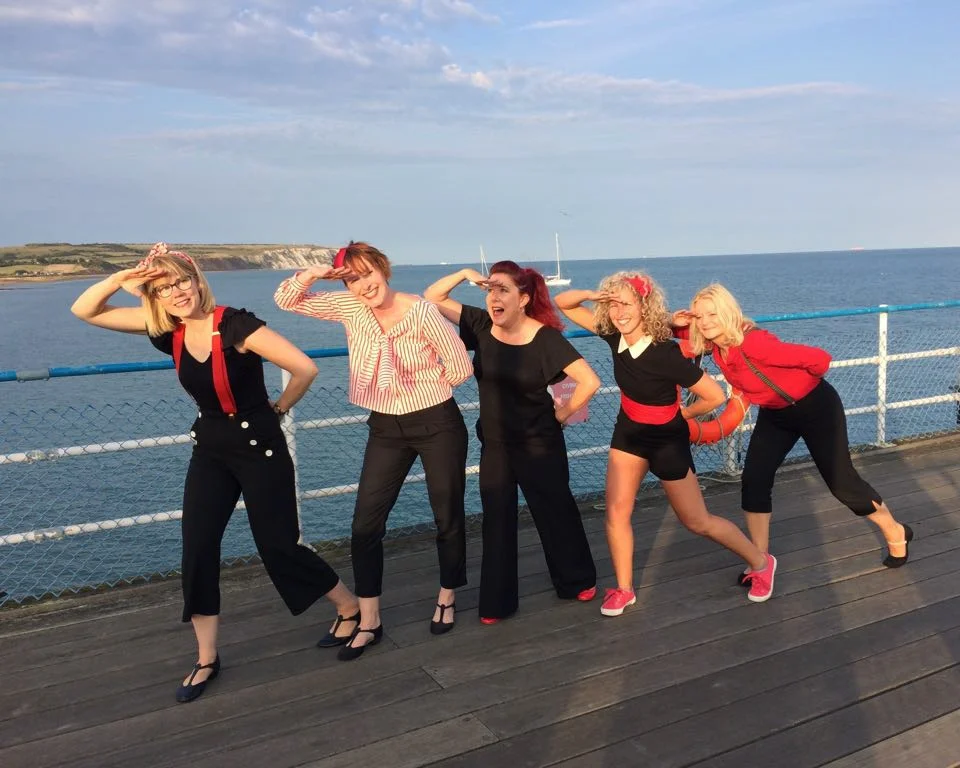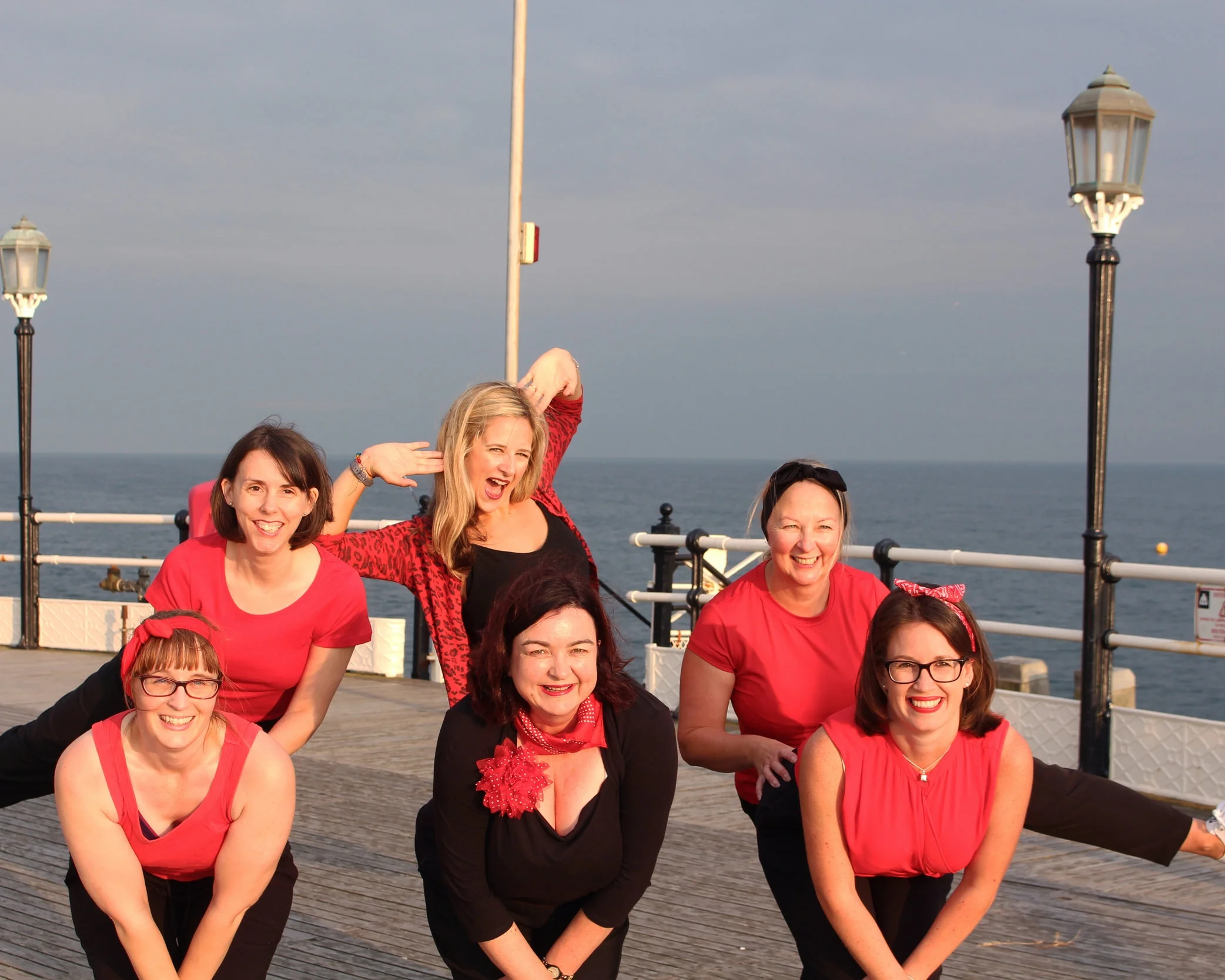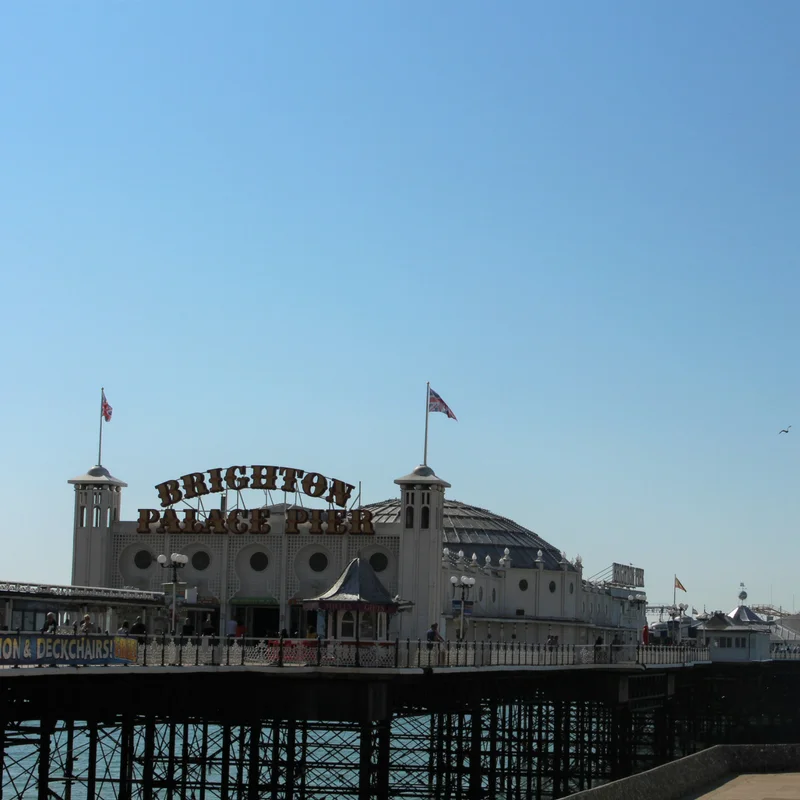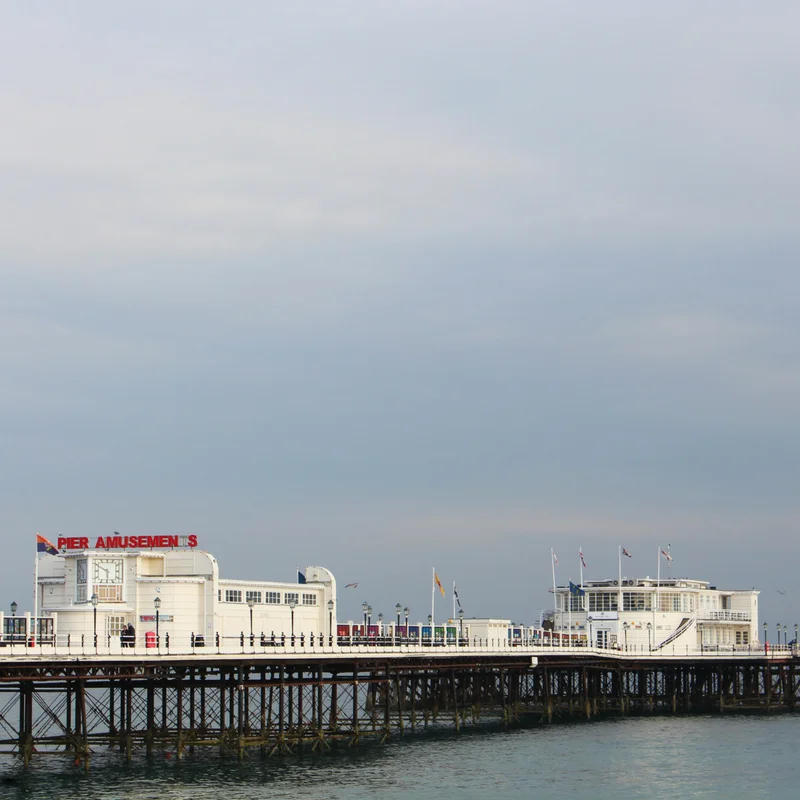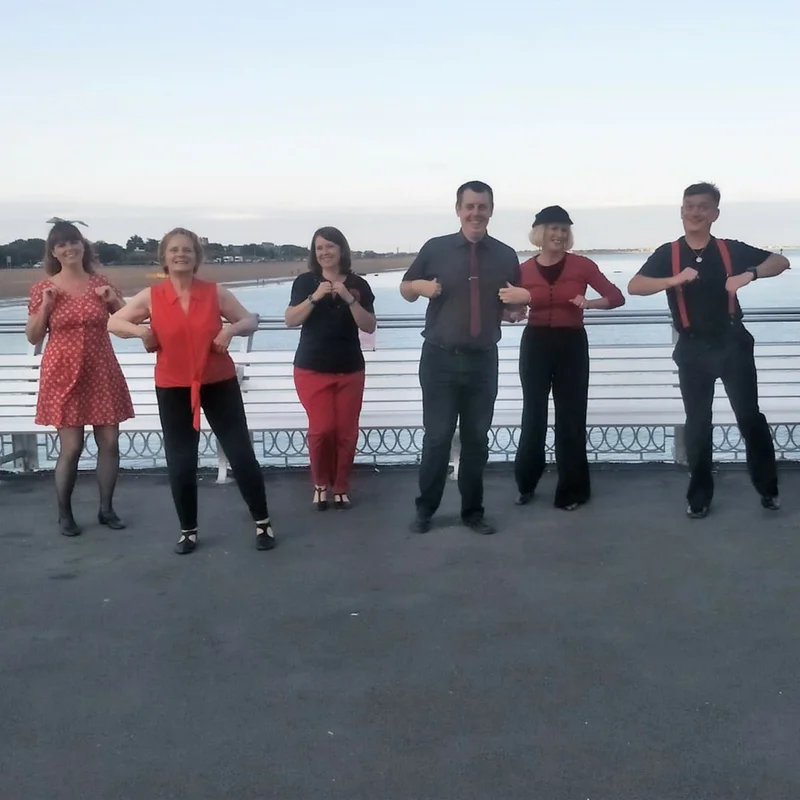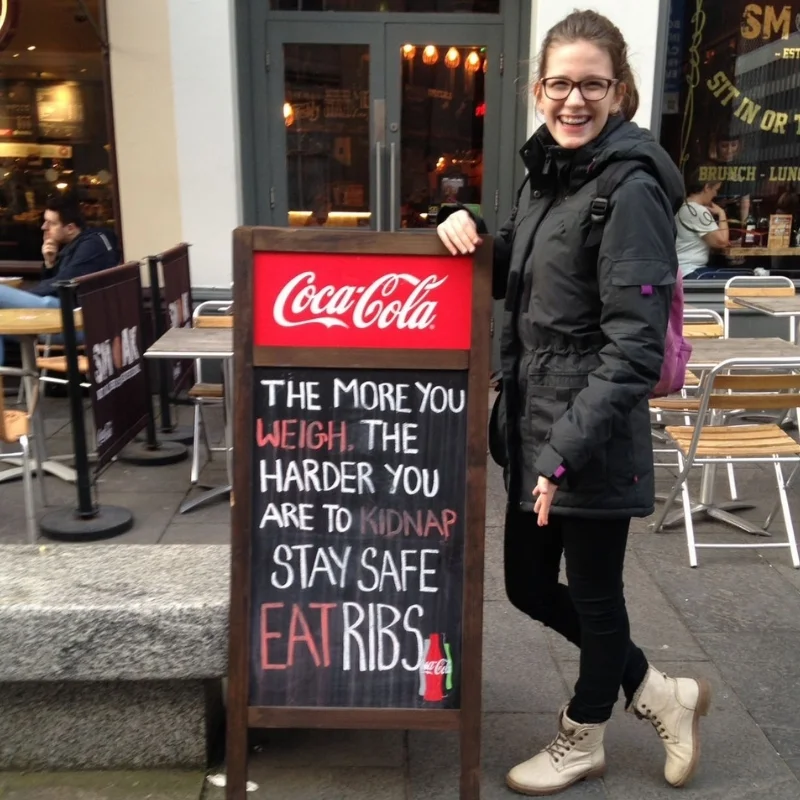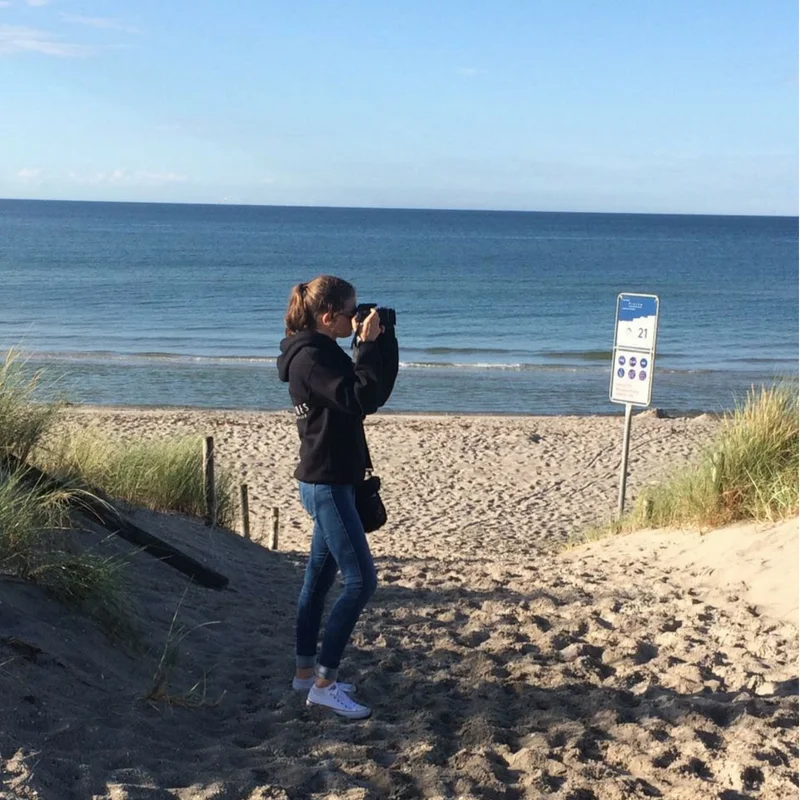
BLOG
Read about all things Charleston
Move of the Week: Squat Charlestons
This week in our series of move of the week we are looking at something which we consider a slightly more technical move: A Charleston Squat
This week in our series of move of the week we are looking at something which we consider a slightly more technical move: A Squat Charleston.
The key things to remember when learning this move is to keep your knees bent in and hips slightly hinged back. You need to make sure you stay low and you are not bobbing up and down with the move.
Each time you try this move you need to bend the leg in then kick out to the side. Once you kick, you swap legs. It is very quick and the best way to make it look flawless is to bend your legs and keep close to the ground.
3 flapper girls you must know
In the 1920s flappers girls broke the image of what a traditional woman should be. They cut their hair short, wore make-up and are what many considered the "modern" woman, breaking away from victorian womanhood. Flapper girls Josephine Baker, Clara Bow and Louise Brooks are maybe the most most famous three from the era but what made them stood out and stand the test of time?
In the 1920s flappers girls broke the image of what a traditional woman should be. They cut their hair short, wore make-up and are what many considered the "modern" woman, breaking away from victorian womanhood. Flappers Josephine Baker, Clara Bow and Louise Brooks are maybe the most famous three from the era but what made them stood out and stand the test of time?
Josephine Baker
JOSEPHINE BAKER
Josephine Baker was born in Missouri in 1906. Originally she was named Freda Josephine McDonald, but after immigrating to France she was known as Josephine Baker.
She is one of the most famous Charleston dancers of the era and her career began as a street dancer, which attracted attention and helped her being recruited as a dancer for the St. Louis Chorus Vaudeville show at the age of 15. Not long after this, she moved to New York City where she performed at the Plantation Club and in the Broadway chorus line of Shuffle Along and The Chocolate Dandies.
After New York, she moved to Paris in France where she stayed until she died. Her Danse Sauvage brought her success overnight, because her skirt was consisting only of a griddle of artificial bananas. It’s one of her most famous pictures and a symbol of the Jazz of the 1920s, and it also gave birth to the term “Art Deco”.
Baker was not only an entertainer but also an activist. During World War Ⅱ, she aided the Red Cross, the French Forces and the French Resistance. And in the United States she refused to perform for segregated audiences and is noted for her involvement in the Civil Rights Movement. In 1975 Josephine Baker died in France.
Louise Brooks
LOUISE BROOKS
Louise Brooks, who was born in 1906, has one of the most iconic flapper looks: Her bobbed hair, The American was a famous dancer, an actress and later in her life an author. She came into the spotlight as Lulu in the film Pandora’s Box.
Her career began at the age of 15, when Brooks dropped out of school to move to New York City to join the Denishawn dance troupe. She performed two seasons with Denishawn, but was dismissed at the end of her second season, because St. Denis, one of the most renowned artists of that time, thought that Brooks was possessed by a superior attitude.
After this, she found work as a Broadway chorus girl and became a Zeigfeld showgirl.
Brooks travelled to England, where she found work at the city’s famed Café de Paris and became the first person to dance the Charleston in London. This helped her get noticed by film star Charlie Chaplin, with whom she had an affair that lasted one summer.
When Brooks was 18 years old, she signed a five-year contract with Paramount, which is still a leading film studio, but in her days, she was never really considered a major star in the film industry. In 1985 Louise Brooks died of a heart attack.
Clara Bow
CLARA BOW
Clara Bow, born Clara Gordon Bow in 1905 was an American actress which became famous through silent films during the 1920s.
At the age of the 16 she participated at the nationwide acting contest, because previous winners got film roles, and Bow wanted to be an actress. She won an evening gown and a silver trophy, but the breakthrough never came after the competition.
In 1921 Bow was introduced to the director Christy Cabanne, who cast her in Beyond the Rainbow and was really impressed by her, but she was cut out in the final print. Bow dropped out of school after this incident and worked a normal job.
But her father encouraged her to keep looking for a film role because it was a huge dream of her. In 1923 she was featured in the silent film Down to the Sea by Elmer Clifton, which helped her getting known as an actress.
One year later Bow got her first lead role in the film Poisoned Paradise.
The appearance in the film It brought her global fame and the name “The It Girl”. Now she is still the personify to the Roaring Twenties and is often described as its leading sex symbol.
In 1965 she died of a heart attack.
Ever fancied learning the Charleston? Check our our courses in studio and online
Strictly Review: Joe Sugg & Lauren Steadman
We were excited to see this week that the Charleston is finally back on Strictly and after weeks of waiting YouTube star Joe Sugg and Paralympian Lauren Steadman were first to perform it. Each week we will be picking apart the routines and giving our score on whether it got us swivelling along with them or just switching the TV off.
We were excited to see this week that the Charleston is finally back on Strictly and after weeks of waiting YouTube star Joe Sugg and Paralympian Lauren Steadman were first to perform it.
Each week we will be picking apart the routines and giving our score on whether it got us swivelling along with them or just switching the TV off.
First up was Joe Sugg and his dance partner Dianne Busell who have set social media alight after showing off their moves to a slightly bizarre Charleston which included them thatching roofs whilst dancing to 'Cotton Eye Joe' by Rednex.
The judges gave him a total of 31 and praised him highly however it has left the audience with mixed feelings. Was this overmarked or rightly deserved?
Well here at MyCharleston we have had a little look and here is our review:
He has plenty of energy and good stage presence so he scores highly for his performance skills but in terms of content it didn’t have that many fundamental steps in it.
If we take a closer look there was only one Charleston in hold which was disappointing for a partner dance and the rest of the Charlestons were all solo. One 30s Charleston and 2 basic 20s Charlestons just before the barrel roll. The knocky knees were weak but the lindyhop section had nice movement.
After faffing about with some ladders, there was only another basic 20s Charleston step, some helicopters and a couple of flapper walks which stood out as classic steps. Although there should have been more swivel, the lifts were great and they have great chemistry onstage.
We would like to see more Charleston content and swivel throughout but that’s the choreography team who determine that and if they are looking for mass appeal it seems to have worked judging by the fact it’s close to getting a million views on YouTube in just 2 days.
Our score: 6
Lauren Steadman & AJ Pritchard
Next to dance the Charleston was Lauren Steadman with her professional partner AJ Pritchard dancing to Postmodern Jukebox ‘New Rules’. For us this one really didn’t work us. We really didn’t understand the storyline for this one. What was the whole thing with the telephone box? It didn’t make sense nor did their acting. Again, there was only one Charleston in hold and then a succession of lifts which are impressive but didn’t showcase the style.
Half way through the routine, Lauren goes back to the phone and does a little Charleston solo but after her insane one-handed lift she lost a bit of focus and goes wrong in the end which is a shame as the end section had the most interesting footwork. Overall, this was very much a lift routine and lacking basis content. The judges total score was 22.
Our score: 5
Agree with our scores? Let us know how you rate the routines in the comments section below
Move of the week: Flapper Walks
The flapper walk is the perfect move to show off your swivel or to use as a transition move between your basic Charleston steps.
The flapper walk is the perfect move to show off your swivel or to use as a transition move between your basic Charleston steps.
The most important thing in this move is to think about swivelling each time you walk and flicking your heels up. Each step forward includes a swivel and a flick - this is what makes it a Charleston step rather than a standard walk.
To add some height to the move bring your arms up above your head and flick your wrists from left to right whilst you are walking forwards. Imagine you are gently tapping a tall person on the head with the action. Keep your elbows straight and avoid having floppy arms as this can look messy.
Get the look: 1920s make-up and hair
The hair and make-up of the Roaring Twenties is one of the most glamorous eras of all time. We often get asked about the style, so here are some easy ways to recreate the most popular looks at that time.
The hair and make-up of the Roaring Twenties is one of the most glamorous eras of all time. We often get asked about the style, so here are some easy ways to recreate the most popular looks at that time.
MAKE-UP
The most defining make-up look of the 1920s was super-strong smokey eyes, with rose-coloured cheeks, dark-red lips and strikingly arched eyebrows.
Amy, our Savoy Kicks member, with 1920s make-up look
The lips
The upper lip was heart-shaped with a thinner lower lip, which creates a round looking mouth.
To recreate the lips, you should start by covering your lips with foundation or concealer to get a smooth base for your lipstick. Then the best way to continue is by lining your lips with a dark lip pencil following your lip shape with light strokes, emphasizing the bend in your upper lip. After this, fill in your lips with a similar colour and your good to go. You may not want to go with the full ‘cupids bow’ but
stick to dark red shades to get the best 20s throwback, because in this decade the dark red lips was the only colour available.
The eyebrows
The eyebrows were dramatically dark, arched and much thinner than we tend to do now.
To get the 20s look: take a dark brown or black and darken your eyebrow. Try to do just a really thin and arched eyebrow, by turning your eyebrows slightly downwards with the eyebrow pencil. Extend the ends to make them look extra long.
The smokey eyes
The eye make-up in the 1920s was super-smokey, which means that with just a smudgy dark pencil you would be good to go. Or you could start off with a lighter grey shade by using this as your base and than just apply a dark eyeshadow on to your eyelids. The more dramatic, the better!
To top it off use a black eyeliner around the eyes, especially on the top lip and curl your lashes or use false lashes to make your eyes stand out even more.
If you need more inspiration for 1920s make-up looks here is the link to the Pinterest board we have created.
Louise Brooks with the popular straight bob
Greta Garbo and typical eyebrows of the 1920s
HAIR
In the 1920s there were many different types of hairstyles, but the most popular ones are straight bobs or finger waves.
Finger waves
To recreate finger waves hairstyle you need a lot of hairspray and pins to hold your hair in place.
If you have longer hair start by making a bun at the nape of your neck, which should be a little bit off-center, but leave some hair out of the bun on the side with more hair on it, so you can create the finger waves.
Now comes the tricky part: Take the hair you left out of the bun and a straighters and start by clamping your iron down on that piece and do half rotation outwards, to create a little wave. Hold it for a few moments and then move a little bit down to do this process again, but this time do a half rotation inwards. Do this as long as it takes you to complete the piece you left out. Now take the pins and pin your waved hair to the side of your face, secure it with hairspray and you are finished.
You could add a 1920s hair band or other hair accessories, which were typical for the 1920s to top off your look, but this isn’t a need.
In the YouTube tutorial below another easy way to do the 1920s finger waves is shown.
If you are looking to do a faux bob, check out blog piece here. and If you need more inspiration for your perfect 1920s hair and make-up look, you can visit our Pinterest board. MyCharleston put together a board with typical hairstyles and make-up looks. If you want to have a look, simply click here.
Now you have got the moves why not learn the 1920s Moves with our online course.
Move of the week: Side to side kick Charleston variations
A side to side kick move is a Charleston variation that derives from the solo jazz world. It is commonly seen in lindyhop as a hand to hand Charleston, danced in partners, but here is the footwork done as a solo move.
A side to side kick move is a Charleston variation that derives from the solo jazz world. It is more commonly seen in lindyhop as a hand to hand Charleston, danced in partners, but here is the footwork done as a solo move.
As a breakdown you need put kick your right foot on the diagonal to the right corner then change direction and switch your feet to face the opposite corner. Place your right foot on the ground and switch it with your left then kick to the left corner.
The key to this step is keeping your weight over the body, feet flexed at all times and a light bounce throughout the movement.
To make the movement seem larger, create large circles with your arms to lift the upper body and fill the space. This makes the step more eye catching and fills the space.
For more Charleston tutorial videos take a look at our YouTube channel and subscribe for the weekly videos.
Charleston Dancing Pier to Pier
MyCharleston dancers are toe tapping their way around some of the south coast’s most iconic landmarks
MyCharleston dancers are toe tapping their way around some of the south coast’s most iconic landmarks
MyCharleston, showcases their students dance talents in a new video entitled ‘Charleston Dancing Pier to Pier’ which brings together dancers on their local piers in Brighton & Hove, Portsmouth, Worthing and Isle of Wight.
Pier to Pier in Brighton
MyCharleston co-founder, Elena Collins says ‘Pier to Pier is a celebration of the beautiful places we teach in and the vibrant people that life there. We wanted to show-off these stunning grade listed piers which are on our doorsteps and demonstrate the towns are dynamic places full of talent.
The Brighton based dance organisation, founded by Elena Collins and Fiona Ring, has gone from strength to strength in the past year as demand has grown for their classes and groups have developed all along the South coast.
‘We noticed a theme appearing that everywhere we taught there was a pier’ chuckled Fiona ‘therefore we wanted to create something which brought all our classes across the south coast together. The locations complement the nostalgic feel of the Charleston and capture people's imaginations of a vintage era’.
Elena said ‘It’s amazing to think that these piers would have hosted the original flapper girls from the Roaring 20’s. We also discovered that 1920’s icons like Charlie Chaplin and Stan Laurel performed at the Brighton Palace Pier to practice their comic skills early in their careers and music legends such as David Bowie and Genesis played on South Parade Pier in Portsmouth’.
‘From all the piers we filmed, the one that really stood out was Worthing Pier.’ comments Fiona ‘The art deco pavilion that was renovated in 2014 transports you back to 1920’s and feels like the perfect place to Charleston dance’.
Our Isle of Wight group
Our Worthing group
The film includes Brighton Palace Pier, Worthing Pier, South Parade Pier in Portsmouth which reopened in 2017, Sandown Pier on the Isle of Wight plus a dance around the twenty-four cast-iron columns now standing by the British Airways i360, which were originally part of the substructure of the West Pier in Hove. The West Pier, is the most at risk Grade Ⅰ listed building in the UK but it’s still the most photographed location in the city.
Elena and Fiona first gained national attention when they released the I Charleston Brighton film back in 2014 when they filmed 80 dancers aged from five to 80 filmed dancing the Charleston in 40 places across Brighton and Hove. Elena said: ‘Creating video content is a huge part of what we do as we love to bring our dance community together and now that we teach in multiple locations it only seemed fitting to create something new’.
‘Our next goal is to get even more people Charleston dancing in new cities so if you have pier in your hometown, we might coming your way’ laughs Fiona.
We would like to thank the following dancers for taking part:
Isle of Wight group:
Bev Burgess
Louise Emery
Mel Griffith
Sarah O'Connell
Kathy Springate
Portsmouth group:
Johanna Newland
Andrew Bellenger
Betty Richmond
Brighton and Hove group:
Mar Balboa
Patricia Butler
Jen Else
Susie Edwards
Faith Holland
Liza Harrison
Sam Hart
Phyllis Hill
Phil Smith
Wendy Smith
Kerry Lemon
Clare Taylor
Worthing group:
Claire Davey
Fleur Howlett
Louise Toney
Madeleine Rishworth
Rebecca Trussler
Teaching team:
Elena Collins
Fiona Ring
Mel Griffith
Rachel Hulme
MyCharleston intern and runner:
Isabell Pagel
The film is dedicated in loving memory of our beloved friends and family whom we have lost in the summer of 2018:
Sam Whitehouse
Daphne Bevis
Ray Lihou
The film was choreographed, edited and directed by Fiona Ring and Elena Collins.
We would like to give an extra special thanks to Rosie Collins and Paul Saunders for inspiring us to make the film.
Move of the week: Learn Knocky Knees
The knocky knees move is a staple to any Charleston routine and instantly recognisable as a classic 1920s step but can often confuse dancers when trying to move their hands and knees to create the illusion.
The knocky knees move is a staple to any Charleston routine and instantly recognisable as a classic 1920s step but can often confuse dancers when trying to move their hands and knees to create the illusion.
As a breakdown you need put your feet hip width apart and in a parallel position with both feet facing forwards. Once in the correct position, bend your knees and think about bringing your knees together and away from the centre of your body.
At the same time start with our hands on your bent knees and cross them when your knees touch in the centre so they are now resting on the opposite knee. You then reverse the motion by bringing your knees together and uncrossing them by putting them back into their original position.
When you feel confident with the step, try a variation by keeping both hands on one knee and swapping both hands onto the other knee each time your legs touch in the centre.
Once you are happy with both moves trying swapping between the two variations.
Remember the lower and more bent your knees are, the more effective the move will look.
The history behind the piers
Over the summer we created the “Pier to Pier” Project, where we filmed with all the summer courses at their local pier the dance routine they learned. To slowly lead you in to the project, we want to tell you a little bit of the history of all the piers we went to.
Over the summer we created the “Pier to Pier” Project, where we filmed all our summer students at their local pier a Charleston dance routine they learned in class. To slowly lead you into the project, we want to tell you a little bit of the history of all the piers we went to.
The Brighton Palace Pier
The Brighton Palace Pier, which was originally named Brighton Marine Palace, was designed by Richard St. George Moore and the construction works were started in November 1881. But the Opening Ceremony was not until 1899, due to a raging storm in 1896, which washed away the remains of the Chain Pier causing serious damage to the partly built Palace Pier. In 2000 the pleasure pier was renamed “Brighton Pier”, which is 1,722 ft long and acknowledged as the finest pier ever built. Today 67.000 lights illuminate the Brighton Pier each night.
And did you know that both Charlie Chaplin and Stan Laurel performed at the pier to hone their comic skills early in their career, before migrating to the US?
Brighton Palace Pier
West Pier
West Pier
The pier was designed and engineered by Eugenius Birch and the West Pier construction works started in 1863. In 1866 the pier was opened. Throughout the history the West Pier had to go through a lot of changes. The pier was designed for entertaining the visitors of Brighton, and it helped, but after World War Ⅱ the popularity declined and the pier needed to be entirely closed in 1974 for safety reasons. Nobody wanted to buy the pier so it fell into disrepair and it got even worse over next years. The West Pier Trust bought the pier for just £100 in 1983, so it got restored and reopened in 1987. In 2004 the pier was entirely destroyed after two fires and a few storms.
Did you know that the West Pier was the first pier to be Grade Ⅰ listed in Britain in 1982? Now it’s the most at risk Grade Ⅰ listed building in the UK. But it’s still the most photographed building in Brighton, because of the sculptural remains of the Pavilion.
Worthing Pier
Worthing Pier
Designed by Sir Robert Rawlinson, the 960 ft long pleasure pier opened in 1862. Over the years the pier had to be rebuilt because of several fires or storms, but also because it was being blown up by high explosives.
In 1898, when there was a grand opening after a complete reconstruction because the towns politicians and businessmen were thinking, that the pier was hardly grand enough to mark the occasion of Queen Victoria’s Jubilee, they were treated Viscount Hampden by one of Queen’s representative.
And in 1940, during World War Ⅱ, a hole was blown into the pier to stop it being used as a landing point for an enemy attack.
Today the Pavilion theatre sits at the northern end of the pier and on the southern end the pavilion has recently been renovated into a café, after having been a night club for several years.
Fun Fact: In the 90s the Pier was really popular among indie fans after it was featured on the front cover of the band Gene’s album To See the Light.
South Parade Pier in Portsmouth
The pier, which was designed by R. Gale and was started to build in 1878, was opened in 1879 by Princess Edward of Saxe-Weimar. Until today the pier has been destroyed by fire three times. One fire was in 1974 during the making of the film ‘Tommy’ by Ken Russel. In one scene with Oliver Reed you can clearly see the smoke. Many famous names have performed on the South Parade Pier, like Frankie Howerd, Peter Sellers, David Bowie or Genesis. And the pier also appeared in an episode of Mr. Bean entitled “Mind the Baby Mr. Bean”.
The in 2017 reopened pier is now an amusement arcade and food outlet.
Our Portsmouth Group
Our Isle of Wight Group
Sandown Pier of the Isle of Wight
The 360 ft long pier was opened in 1879. In 1895 the pier was extended to 875 ft with a landing stage for passenger steamers and a pavilion was also built on the pier. In 1965, when Louis Mountbatten was installed as Lord Lieutenant of the Isle of Wight, Queen Elizabeth Ⅱ and Prince Philip toured the Island and at the end of the tour the Queen attended a ceremony at the pavilion.
Afterwards the pier underwent major renovations and alterations, but it was reopened in 1973.
Today the Sandown Pier still hosts an amusement arcade, many bars and a café and it still remains popular with fishermen, tourists and those who want to do a seaside cruise.
The whole video to show you the result will be uploaded to our MyCharleston YouTube site and Facebook site, when it’s ready. So, stay tuned!
MyCharleston Stories: Isabell
We are very excited to welcome our new intern Isabell to our team who will be working with MyCharelston for the next three months and helping us with all things social. Isabell has travelled over from Germany especially for the internship and as tradition we always like our readers to get to know our team so here is our 60 second interview with Isabell.
We are very excited to welcome our new intern Isabell to our team who will be working with MyCharelston for the next three months and helping us with all things social. Isabell has travelled over from Germany especially for the internship and as tradition we always like our readers to get to know our team so here is our 60 second interview with Isabell:
Isabell in Scotland.
1. Where did you grow up?
In a small village near Hanover in Lower Saxony.
2. Why did you want to do your internship in the UK?
Because I love travelling and when I was in England in 2016 I fell in love with this place. I also think that it’s a great opportunity for me to learn new things every day, for example about British culture or life and the work, but also about me.
3. What’s the last thing you watched on TV and why did you choose to watch it?
On Netflix the film ‘To All The Boys I’ve Loved Before’, because I loved the books, and so I needed to see if the film is at least as good as the book.
4. What songs are included on the soundtrack to your life?
Wie Ich, by Kraftklub
You Will Be Found, from the Musical ‘Dear Evan Hansen’
Isabell and her exchange student.
5. If you could learn to do anything, what would it be?
To speak Portuguese, because then I could understand the family of my Brazilian exchange student.
6. If you won the lottery, what is the first thing you would do?
Thanking my parents by buying them a trip to anywhere they would like to go, because they made it possible that I were able to travel to Brazil, Scotland and England in the last two years and now England again for three months.
7. If you could travel anywhere in the world, where would it be?
Canada, Sweden and New Zealand.
8. If you could be any fictional character, who would you choose?
Hermoine Granger from Harry Potter.
Isabell photographing in Germany.
9. What's your favourite indoor/outdoor activity?
Indoor - reading and writing
Outdoor - photographing
10. What chore do you absolutely hate doing?
Cleaning the cage from my budgies.
11. If you could meet anyone, living or dead, who would you meet?
Walt Disney, because I grew up watching Disney movies and I still love them. I admire him for his creativity and for what he did.
Isabell with her sister at the "Erntefest" in her hometown.
12. Where has been your favourite place to visit?
The Iguazu Falls in Brazil.
13. What three traits define you?
Kind, creative and helpful.
14. After your internship what is next for you?
I'm going back to Germany to study.
15. What one thing should an English Person try, or do, in Germany?
They should definitely try German bread and Lebkuchen. And they could visit a "Erntefest", which is basically a harvest festival which preserves old traditions, with dancing and a pageant.
16. What are you looking forward to the most during your stay in Brighton?
To explore Brighton and its surroundings, to get some good photos. But also to meet new people.




